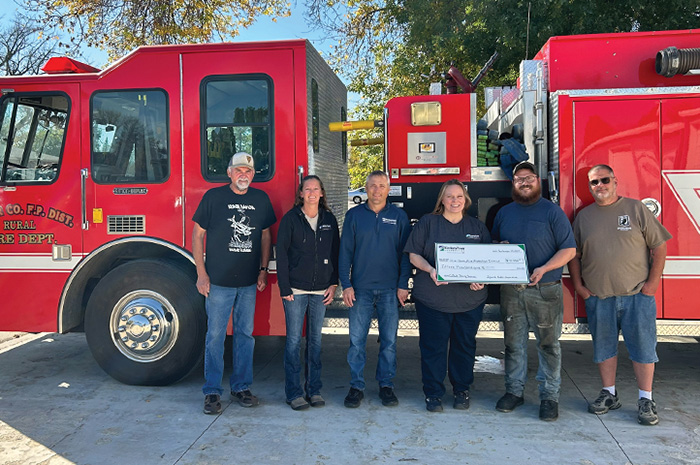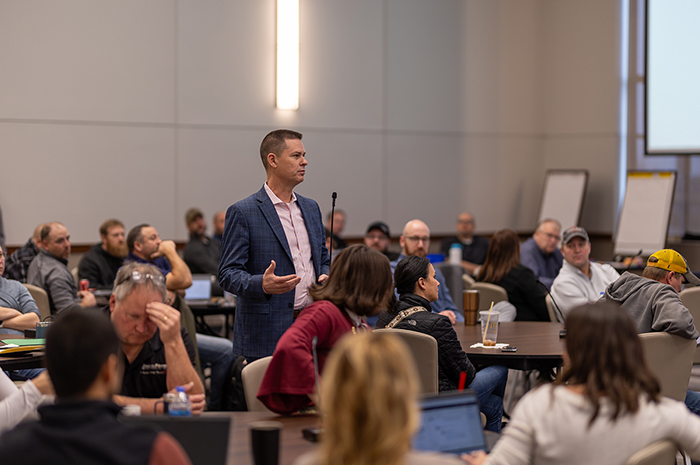Winds of destruction
When a June 20 storm ripped through Minnkota's service territory, power delivery crews were quick to respond to historic, system-wide damage.
On June 20, the longest day of the Midwest summer, a storm began to build in western North Dakota. The severe weather watches were on everyone’s lips, as is always the case in farming and ranching country. But no one knew, in the friendly chatter, what was really to come.
By daybreak on June 21, a path of devastation wrought by high winds and tornadoes stretched more than 300 miles from west of Bismarck, North Dakota, to the rural areas of Bemidji, Minnesota. Already, crews from Minnkota Power Cooperative and many of its member cooperatives had been working through the night, trying to assess the extent of the damage and restoring power where they could. The sunrise revealed this would be no quick fix.
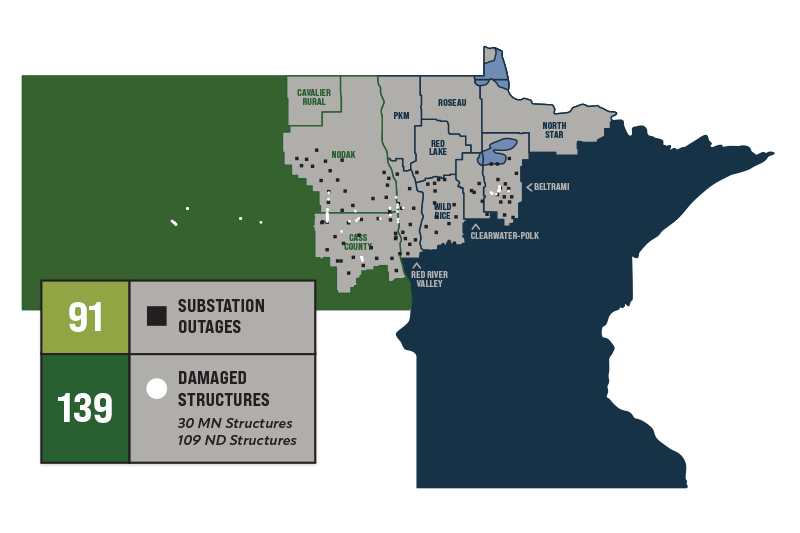
Bismarck, North Dakota – June 20-22 (The first 72 hours)
Minnkota Line Superintendent David Lagge’s family was settling into a Friday night at the lake when the tornado warnings started to ping on June 20. The alerts were for the area between him and Minnkota’s Milton R. Young Station power plant in Center, North Dakota, 45 miles to his south.
“The first call came in from dispatch to me at around 10:15 p.m.,” Lagge said. He was told the 345-kilovolt transmission line, which carries power from western North Dakota to Minnkota’s service territory on the eastern side of the state and northwestern Minnesota, was having challenges. “The relay data was showing it somewhere out by the plant.”
Lagge called a crew out from Grand Forks to assess the line damage, which was impacting both 345-kV lines from the plant. Then, he was told part of the 345-kV stretch from Jamestown to Fargo was also off.
“The tornadoes and the storms were traveling east, kind of right there on the Interstate 94 corridor. As we watched the radar more, we knew – holy cow,” he said. “It was travelling north of I-94, and our 345 line is just north of I-94. We were like, how much of that line is going to be laid down?”
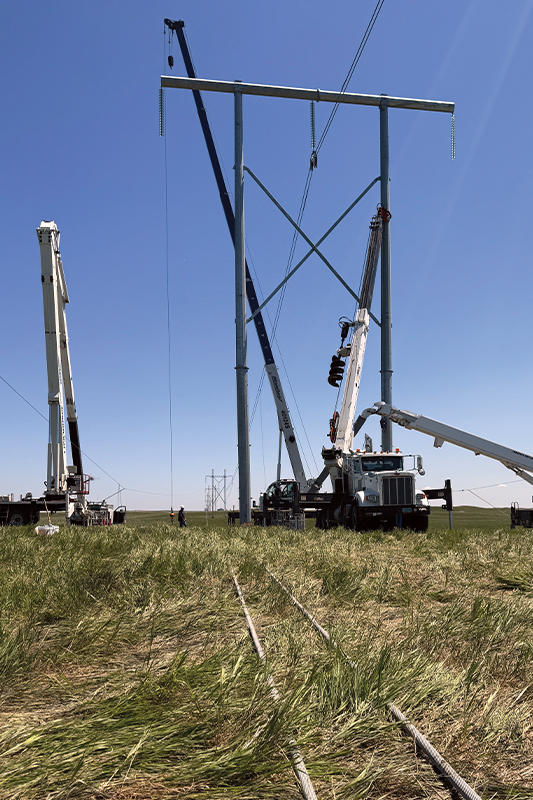
The storm, having already damaged four 345-kV structures and more than 30 230-kV between the power plant and Bismarck, lost no strength as it continued through the rest of the service territory. Lagge and his team continued to work with Minnkota’s control center through the night to get a handle on where there was damage.
“It was challenging in the beginning for all of us who were trying to help guide and direct the restoration process,” explained Power Delivery Operations Manager Harold Narlock. “We were trying to understand where we were as far as what's on the ground, where the structures are and where we should focus our resources.”
Fog and wind were making it nearly impossible for Minnkota crews to assess the damage in the west, so Lagge teamed up with a helicopter pilot to patrol the 345-kV line from above. He was able to spot the damage and develop a game plan to make repairs with the help of a crew from Western Area Power Administration (WAPA). Over the course of the next few days, assistance would come from WAPA, Basin Electric Cooperative and Otter Tail Power Company.
By the time the system exited Minnkota’s region, nearly 140 structures laid broken or damaged and 87 substations had gone out of service. All substations were back online within 72 hours, and built-in redundancies allowed power system operators to reroute and restore power to member cooperatives, even as miles of line lay on the ground.
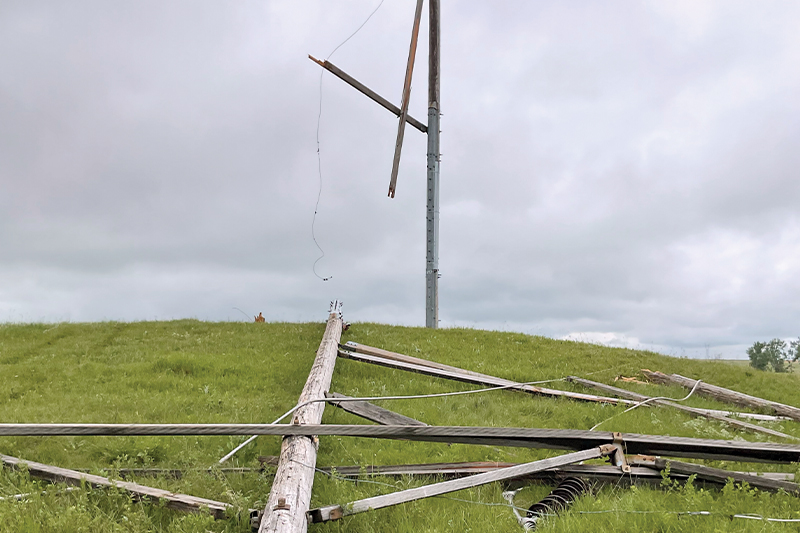
The crews of lineworkers, electricians and utility workers had already gone three days with little rest. But the restoration effort was just starting.
“If you have overboots on, and you walk in the mud out there, your feet now weigh between five and 20 pounds. That just wears you out. And they just keep going,” Lagge said. “Minnkota’s blessed to have the group that we have.”
Grandin, North Dakota – June 23 (Three days later)
Crumpled metal grain bins were strewn across the early growths of corn and beans northeast of Grandin, North Dakota. Derecho winds pushing 80 miles per hour made short work of structures that had stood for decades, including several transmission power lines.
“It’s amazing to see how many grain bins are a quarter mile out in the field away from the farm. It’s like, holy moly,” said Minnkota lineworker Nolan Belle, preparing to help replace another 69-kilovolt pole at the edge of a bean crop. He had already patrolled several damage sites on the eastern side of the state, and he had one word for it – carnage. “There were a couple of times when we’d see a pine tree, without any other pine tree around, just laying out in the middle of the field.”

Belle’s foreman, Butch Tester, had seen much of the same over the past few days.
“This is the worst summer storm that I’ve ever been on, since I’ve been here – 28 years,” he said, driving his truck to the next broken pole a couple miles down a gravel road. “And it was so widespread, from Center to Bemidji, and a wide path. That hardly ever happens. We literally had issues across pretty much our whole system.”
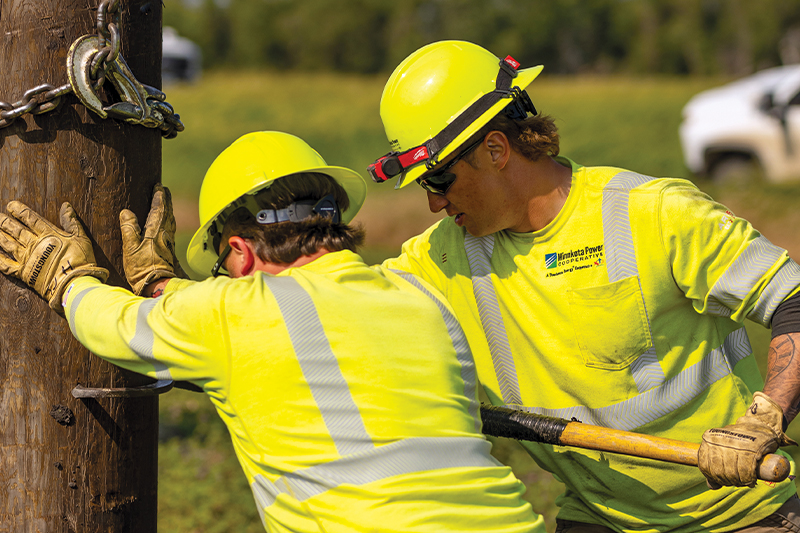
Tester was called out to the damage near Center and Bismarck at 10:30 p.m. on June 20, at the start of the night of mayhem to come. He was out working until 9 p.m. the following night. He’d been pulling similar hours for the past three days, as had his crew. But he was still upbeat.
“We don’t want stuff to fall down, and we don’t want people to be out of power, we don’t want major disasters. But when the [stuff] does hit the fan, the linemen step up. That’s just how we are. That’s our mentality,” he said. “Yes, we get tired, hungry and thirsty. But we just push through.”

Lineworkers get used to work like this. But what happens when a “100-year storm” strikes when you’ve marked fewer than 100 days on the job, like apprentice lineworker Drew Boen? “He got his baptism by fire with Nolan and these guys on his first night,” Tester said with a paternal grin.
Boen was anointed that week, but it’s hard to feel heaven-bound when you’re working through hell.
“I heard in Enderlin, they can’t even find some of the poles that are supposed to be there,” Nolan said as his crewmates cracked open energy drinks behind him.
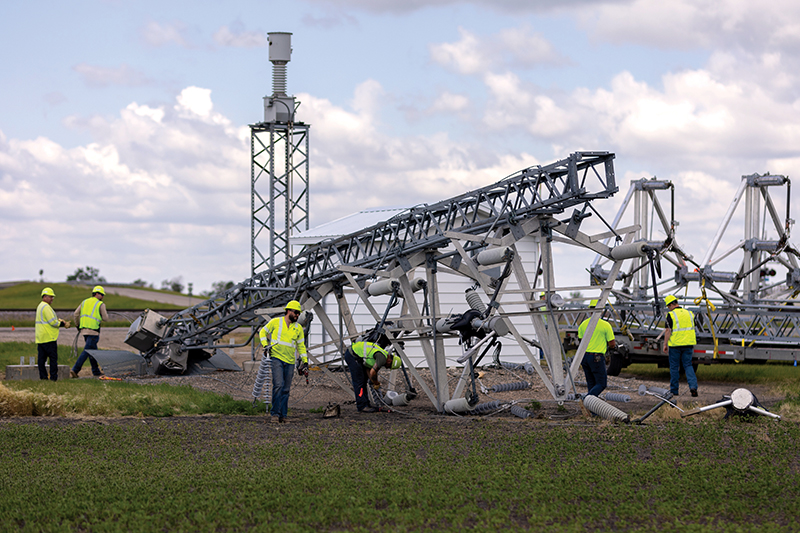
Enderlin, North Dakota – June 25 (Five days later)
Just east of Enderlin, North Dakota, an EF-3 tornado with winds exceeding 165 mph cut a trail 12 miles long and 3 miles wide across the prairie. Homes, barns and equipment were destroyed, claiming the lives of three people and breaking the spirit of many others.
Minnkota line foreman Tyler Pawlowski looked at the broken trees surrounding the creek, his eyes following the power line pulled across a flattened field to the northeast. “You can tell the tornado went right through where we’re standing,” he said.
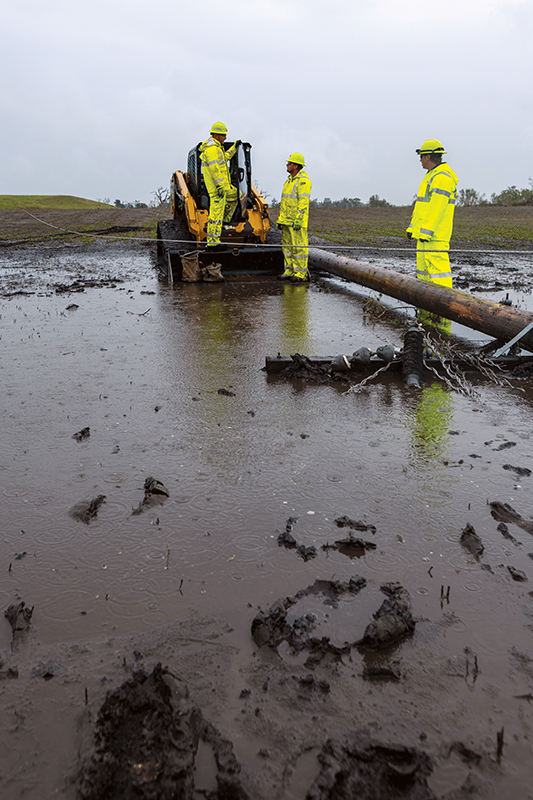
A 1.1-mile stretch of 69-kV transmission line fell victim to the tornado, with 16 poles snapped and thrown up to 500 yards in opposite directions. When crews first arrived on scene, they couldn’t even find the structures – the very ones Pawlowski set his first summer with Minnkota, nearly two decades ago.
“We built this line back in 2006,” he said. “It’s pretty crazy.”
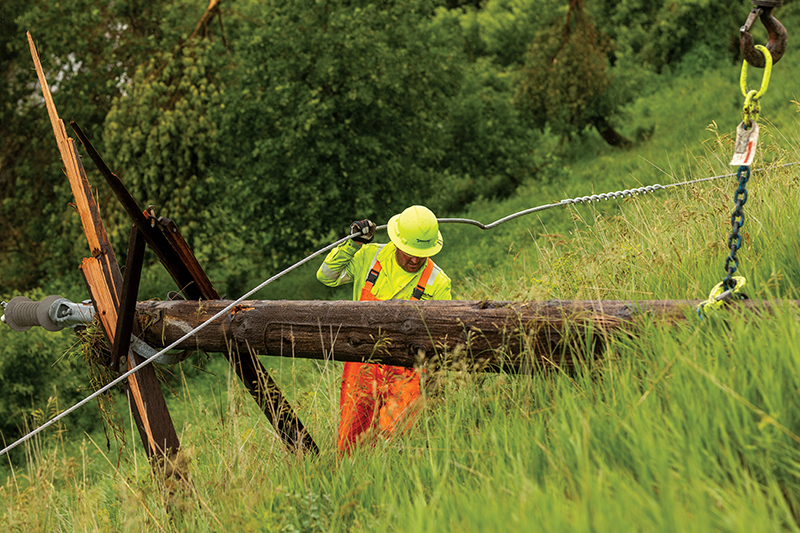
As the line crew began to prepare new poles to fill the void left by the twister, Minnkota’s utility crew cleaned up the broken remains tossed across the acreage. Like nearly all the co-op’s power delivery crews, utility workers Blake McDonald and Casey Anderson had been working long hours for many days.
“Sunday I saw a bunch of poles – some were just barely broken, and some were snapped off completely. There are lines down, some of them sitting on the road. People can’t get to their houses and their farmsteads,” McDonald said. “It’s a mess.”
“It’s a nightmare,” Anderson added in calm disbelief. “It’s going to be a long time before people get back to their norm.”
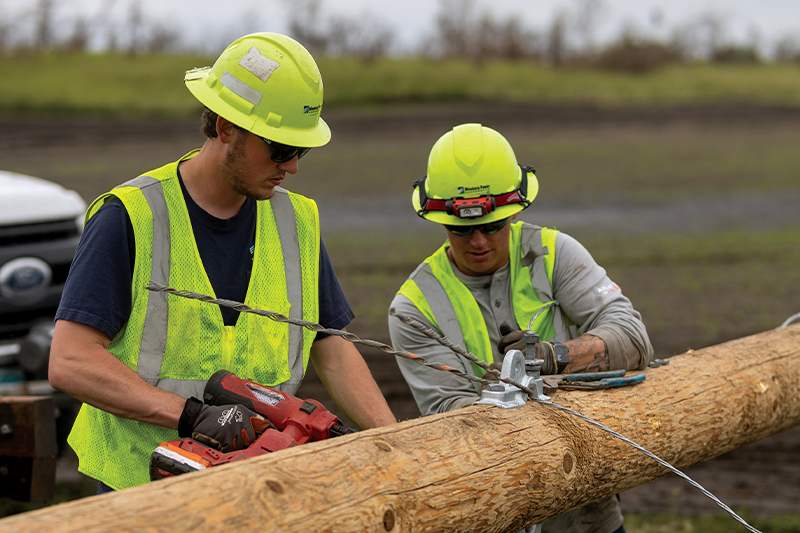

Pawlowski has never seen a summer storm of this intensity – of this breadth – in his career. Nor had his crew mates. They spoke of laminate power poles, known for their unbreakable strength and weight, snapped in half, one after another, for miles near Bismarck. Another 300 miles away in Bemidji, Pawlowski’s parents were enjoying a weekend away when the same system blew through.
“They were in their camper and they thought it was going to tip over,” he said. “My parents have been camping for 20, 30 years, and that’s the most scared they’ve ever been.”
Bemidji, Minnesota – June 27 (Seven days later)
A week after the storm, line foreman Nick Bye and his crew were finally getting to the puzzle of replacing a seven-pole span of transmission line in Bemidji. While half of the line lay tangled in trees and a marshy, poison-ivy-and-tick-infested clearing, the other half was twisted into a salvage yard of bent-up, rusted-out husks of automobiles past.
“Right now, we’re getting the wires off of all of the vehicles and getting them up in dollies so we can bring the wire up on a dead-end pole that broke down here,” Bye said, pointing far past the pickups and mud pits to the end of the line.
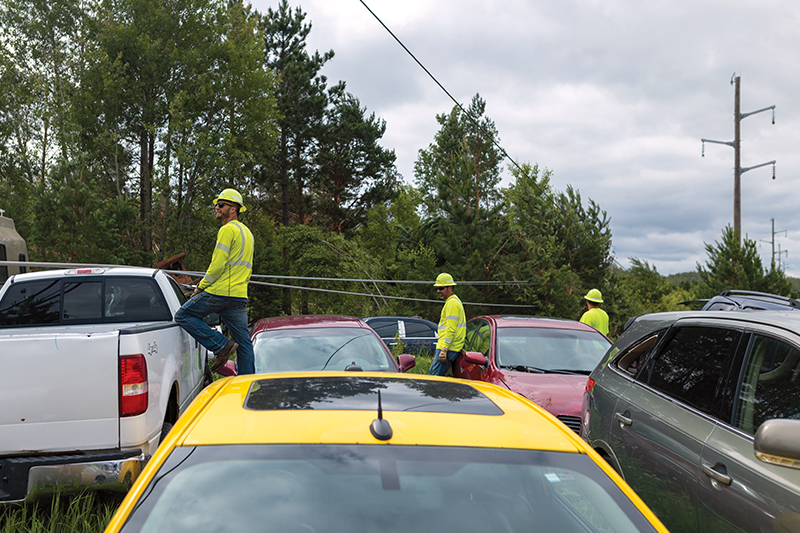
The community of Bemidji was one of the hardest hit by the June storm system. Torrential rain led to flash flooding in lower areas, and the wind leveled acres of woodland the northern Minnesota region is known for.
“Over here, trees are taken down – all the trees. A lot of roofs blown off around here. It’s been a little bit of everything,” Bye said. “We’ve had our small storm jobs, but nothing to this scale. This is life-changing for them.”
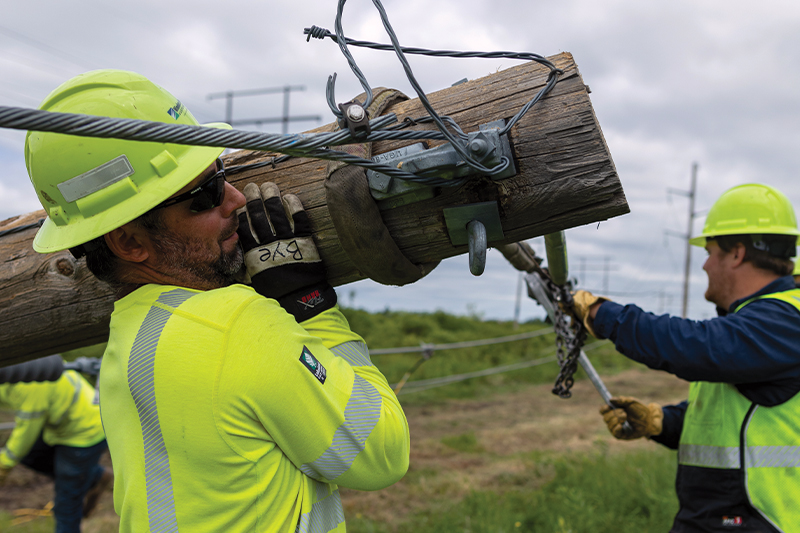
However, through this disaster, those living in the community remained resilient. Neat piles of logs began to accumulate in yards as neighbors helped others clear fallen trees, many over a century old. The #BemidjiStrong hashtag quickly gained traction on social media. Signs began to appear, voicing gratitude for the first responders and line crews.
“There was a guy the other night who stopped us and said, ‘Thank you guys – appreciate it,’” Bye said.

As terrible as the aftermath of the storm was in Bemidji, Bye had already experienced a lot of devastation across Minnkota’s footprint over the past week of restoration. The night of June 20, he was one of the first lineworkers to arrive on the scene in Enderlin, where a tornado had just laid waste to the countryside a couple of hours before. Driving through the dark, he couldn’t yet see much of the damage, but he came upon a car parked on the side of the road. He stopped to see if he could offer help to the two people inside.
“A woman walks up, and she’s like, ‘It’s gone. It’s all gone.’ And her voice was just shaking,” he recalled. “I was like, ‘Your house?’ And she said, ‘Yeah. We lost it all.’”
Bye says he remained with the couple until he knew they had a plan and then continued to patrol.
“Once it got light out, I saw that just everything was gone. Then I started walking,” he said, describing the wet fields where Minnkota’s transmission line stood just hours before. “There you could see there was a quilt out there, and then I was walking and there was a senior picture.”
A majority of Minnkota’s system was repaired in under two weeks due to the tenacity of the lineworkers, electricians, utility workers and others who devoted the entirety of the summer’s first days to restoring power to the region. The June 20-21 storm activated one of the largest collaborative response efforts in the cooperative’s history.
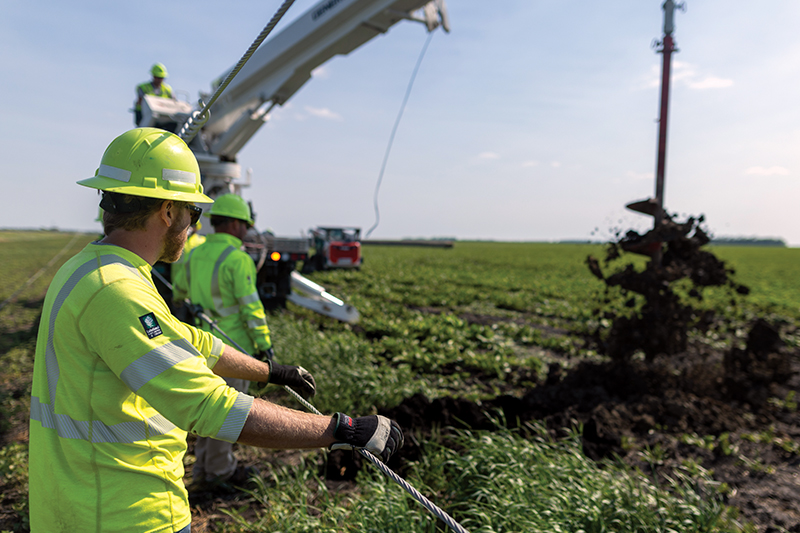
It was difficult. At times, it was heartbreaking. But Minnkota and its members will be stronger because of it.
“We can run scenarios, we can do training. But there’s no better experience than living through it,” Narlock said. “We don’t want storms, but we learn a lot every single time. And I think the crews just keep getting better at what they do.”
...

